| |
13:30
 |
0940.
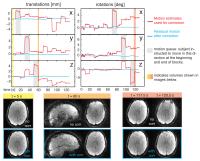 |
Motion correction for functional MRI with hybrid
radial-Cartesian 3D EPI 
Nadine N Graedel1, Mark Chiew1, and
Karla L Miller 1
1FMRIB Centre for Functional MRI of the Brain,
University of Oxford, Oxford, United Kingdom
We used a hybrid radial-Cartesian 3D EPI trajectory with a
golden ratio based angle update to perform retrospective
motion correction in severely motion corrupted fMRI data.
Motion estimates were based on high temporal resolution
image timeseries and and k-space based estimates. The
calculated rotations and translations were corrected in
k-space prior to the final reconstruction, allowing the
correction of both inter- and intra-volume motion artifacts.
This approach is self-navigated, requires no additional
hardware and is suitable for correction in fast fMRI
acquisition.
|
| |
13:42
 |
0941.
 |
Ultra-fast gradient echo EPI with controlled aliasing at 3T:
simultaneous multi-slice vs. 3D-EPI 
Rüdiger Stirnberg1, Willem Huijbers1,
Benedikt A. Poser2, and Tony Stöcker1,3
1German Center for Neurodegenerative Diseases (DZNE),
Bonn, Germany, 2Faculty
of Psychology and Neuroscience, Maastricht University,
Maastricht, Netherlands, 3Department
of Physics and Astronomy, University of Bonn, Bonn, Germany
We conducted a feasibility study to compare state-of-the-art
simultaneous multi-slice EPI vs. segmented 3D-EPI – both
utilizing equivalent undersampling techniques for controlled
aliasing – optimized for ultra-fast whole-brain fMRI at 3T.
We compared temporal signal-to-noise ratio, sensitivity per
unit scan time and temporal whole-brain spectra of 8 minutes
time-series. While both fast sequences are well-suited to
separate physiological from BOLD signal, the 3D-EPI sequence
achieves greater sensitivity and signal-to-noise ratio
throughout the brain using whole-brain protocols matched for
identical TR.
|
| |
13:54
|
0942.
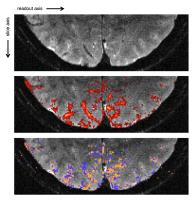 |
Evaluation of SLIce Dithered Enhanced Resolution Simultaneous
MultiSlice (SLIDER-SMS) for human fMRI at 3T 
An T. Vu1,2, Alex Beckett1, Kawin
Setompop3, and David A. Feinberg1,2
1Helen Wills Neuroscience Institute, UC Berkeley,
Berkeley, CA, United States, 2Advanced
MRI Technologies, Sebastopol, CA, United States, 3Martinos
Center for Biomedical Imaging, Charlestown, MA, United
States
We evaluate the synergistic combination of super-resolution
and SMS for high-resolution whole brain fMRI. We find that
SLIDER-SMS can acquire high resolution, high CNR fMRI data
at 3T which is normally only acquired at 7T. The regularized
deblurring/reconstruction of SLIDER yielded 40% more BOLD
CNR than normally acquired high resolution (HR) data, while
omitting the deblurring step altogether yielded 100% more
BOLD contrast with similar high k-space frequency tSNR.
Future use of SLIDER for fMRI may enable robust columnar
level results at 3T and allow higher spatial resolution fMRI
investigations at 7T than currently possible.
|
| |
14:06
|
0943.
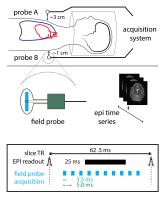 |
Physiology Recording with NMR Field Probe: Application to
de-Noising of fMRI Time-Series at 7 Tesla 
Laetitia Vionnet1, Simon Gross1, Lars
Kasper1,2, Benjamin Emanuel Dietrich1,
and Klaas Paul Pruessmann1
1Institute for Biomedical Engineering, University
and ETH Zurich, Zurich, Switzerland, 2Translational
Neuromodeling Unit, Institute for Biomedical Engineering,
University and ETH Zurich, Zurich, Switzerland
NMR field probe were used to record subject physiology at
7T. The signals were used to de-noise fMRI dataset and
showed to be equivalent to standard devices.
|
| |
14:18
|
0944.
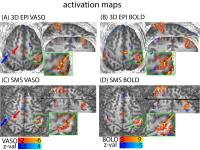 |
Blood volume fMRI with 3D-EPI-VASO: any benefits over SMS-VASO? 
Laurentius Huber1, Dimo Ivanov2, Sean
Marrett1, Puja Panwar1, Kamil Uludag2,
Peter A Bandettini1, and Benedikt A Poser2
1Section of Functional Imaging Methods, National
Institute of Mental Health, Bethesda, MD, United States, 2MBIC,
Maastricht University, Maastricht, Netherlands
Cerebral blood volume (CBV) fMRI has the potential to
overcome known limitations of BOLD fMRI with respect to
spatial specificity and quantifiability of mapping brain
activity. To overcome the coverage limitations of
conventional CBV mapping with VASO, a novel VASO method with
3D-EPI readout was developed. This new approach is compared
to BOLD fMRI and VASO with simultaneous multi-slice EPI
readout. We provide evidence for a high sensitivity and
improved specificity of 3D-EPI VASO compared to conventional
BOLD fMRI. We conclude that because of its superior
resolution in slice-direction, 3D-EPI VASO may play an
important role in high-resolution fMRI.
|
| |
14:30
|
0945.
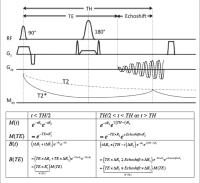 |
Optimization of Asymmetric Spin Echo Pulse Sequences in
Functional MRI 
Eun Soo Choi1 and
Gary Glover2
1Electrical Engineering, Stanford University,
Stanford, CA, United States, 2Radiology,
Stanford University, Stanford, CA, United States
In BOLD contrasts fMRI, the most commonly used sequences,
gradient-echo and spin-echo, have been challenged due to
their limited spatial specificity or functional sensitivity.
As an alternative, an asymmetric spin-echo sequence was
introduced, yet, its characteristics in different conditions
are still unclear. In this study, we performed simulations
and in-vivo experiments to design the optimal ASE pulse
sequence that maximizes functional sensitivity while
preserving high spatial specificity.
|
| |
14:42
|
0946.
 |
Simultaneous Multi-slice Inverse imaging for high temporal
resolution fMRI 
Ying-Hua Chu1, Yi-Cheng Hsu1, and
Fa-Hsuan Lin1
1Institute of Biomedical Engineering, National
Taiwan University, Taipei, Taiwan
We proposed the simultaneous multi-slice (SMS) inverse
imaging (InI) method to achieve 10 Hz sampling rate and
significantly improved spatial resolution (30-fold higher
than typical inverse imaging; quantified by point-spread
function). SMS-InI was demonstrated in a visual fMRI
experiment showing maps of brain activity similar to EPI and
hemodynamic response with 0.1 s precision.
|
| |
14:54
|
0947.
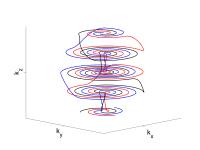 |
An interleaved spherical stack-of-spirals trajectory for fast
segmented whole brain fMRI 
Bruno Riemenschneider1, Jakob Assländer1,
Pierre Levan1, and Jürgen Hennig1
1Medical Physics, University Medical Center
Freiburg, Freiburg, Germany
We investigated a segmented version of the spherical
stack-of-spirals trajectory that retains highly efficient
data sampling and signal recovery, but grants more
flexibility in data sampling compared to the single-shot
version. Whole brain acquisition with nominal isotropic
resolutions of 3mm in 195ms and 2.25mm in 260ms using 3- and
4-fold segmentation have been investigated. The faster read
out along the slowest encoding direction leads to reduced
off-resonance artifacts in comparison to the single- shot
version, and higher sampling rates allow non-regularized
reconstruction.
|
| |
15:06
 |
0948.
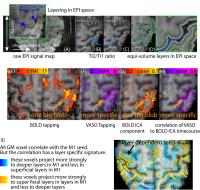 |
Effective Connectivity Measured with Layer-Dependent
Resting-State Blood Volume fMRI in Humans 
Laurentius Huber1, Daniel A Handwerker1,
Javier Gonzalez-Castillo1, David C Jangraw1,
Maria Guidi2, Dimo Ivanov3, Benedikt A
Poser3, Jozien Goense4, and Peter A
Bandettini1
1Section of Functional Imaging Methods, National
Institute of Mental Health, Bethesda, MD, United States, 2Human
Cognitive and Brain Sciences, Max Planck Institute, Leipzig,
Germany, 3MBIC,
Maastricht University, Maastricht, Netherlands, 4Institute
of Neuroscience and Psychology, University of Glasgow,
Glasgow, United Kingdom
Measurements of layer-dependent cortical activity provide
insight on how feedforward/feedback functional connectivity
affects a given cortical area. Here, we simultaneously
measure layer-dependent changes in resting-state BOLD and
CBV with VASO. We demonstrate that the superior specificity
of CBV fMRI reveals layer-dependent resting-state activity
better than GE-BOLD fMRI and gives indications of effective
connectivity in the human sensory-motor system. In
particular, superficial and deeper layers in M1 show
different connectivity patterns than those associated with
the middle layer, likely driven by input from S1. Our data
show that the middle layer in M1 correlates with
contralateral M1, while it anti-correlates with
contralateral S1.
|
| |
15:18
 |
0949.
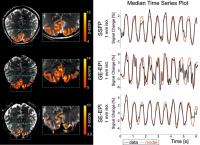 |
The BOLD-sensitivity of balanced SSFP at very high fields is
similar to GE-EPI but more selective to small vessels. - Permission Withheld
Mario Gilberto Baez Yanez1,2, Phillip Ehses1,3,
and Klaus Scheffler1,3
1Max Planck Institute for Biological Cybernetics,
Tuebingen, Germany, 2Graduate
Training Centre of Neuroscience, Tuebingen, Germany, 3Department
of Biomedical Magnetic Resonance, University of Tuebingen,
Tuebingen, Germany
The excellent sensitivity and stability of BOLD-imaging with
balanced SSFP (bSSFP) on humans at 9.4T has been
demonstrated in a recent paper. Here, we analyze the signal
change of bSSFP for different vessel (spheres) sizes and
susceptibility differences for different repetition times
and flip angles using Monte Carlo simulations and
experiments on micro spheres, and compare it to gradient
echo EPI. Simulated and measured signal changes (using
values of susceptibility changes and vessel sized comparable
to a typical BOLD experiment at 9.4T) of bSSFP are in the
range of 10 to 15% with a peak sensitivity to the vessel
(sphere) size at about 3 mm, and a decreased sensitivity for
larger vessels (spheres). For GE-EPI, signal changes are
similar to bSSFP, however, no selectivity to small vessels
is visible
|
|












